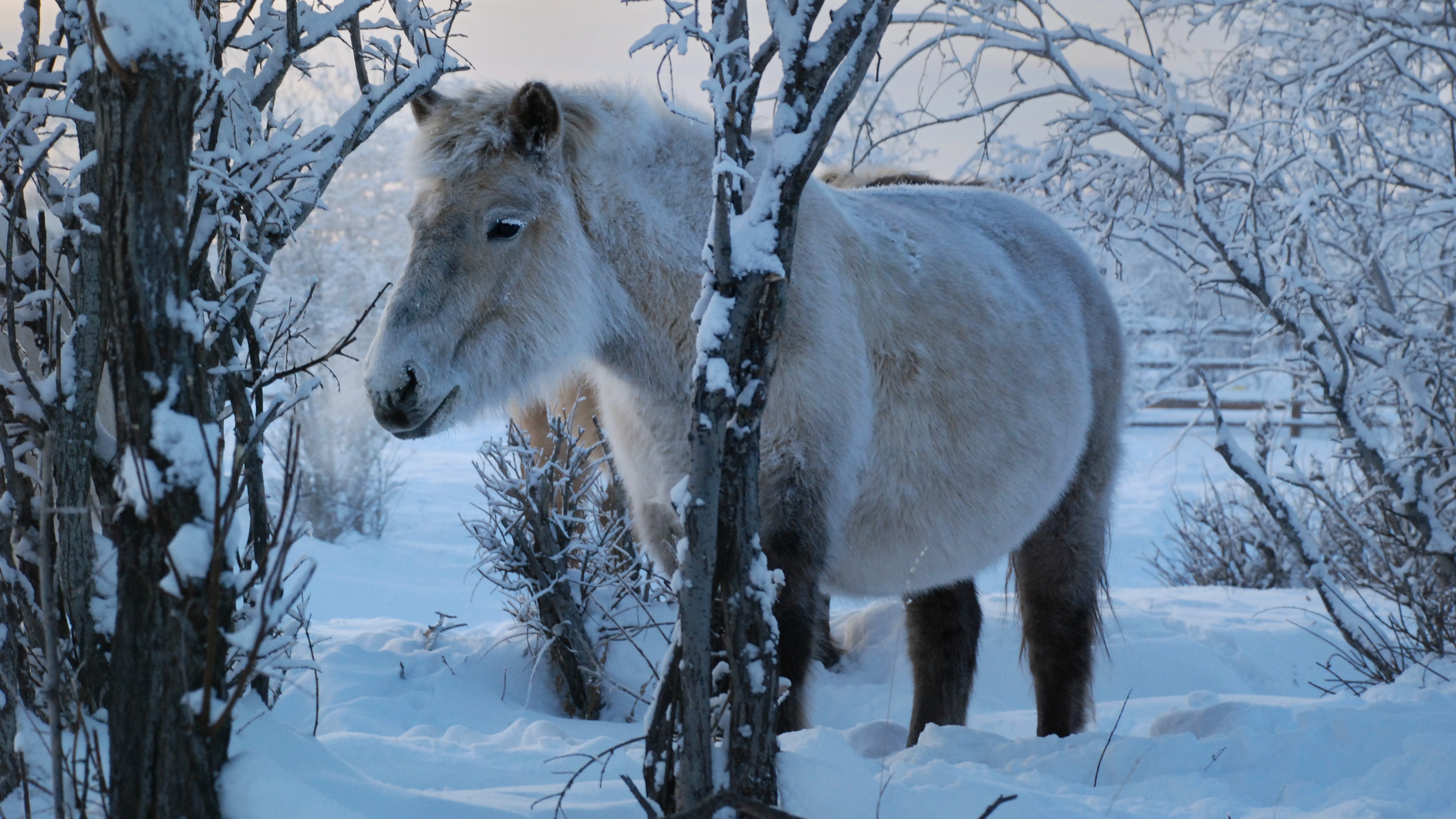How the mystery origins of hairy little Yakutian horses were uncovered in Siberia’s ‘gateway to the underworld’
By Ludovic Orlando
Copyright livescience

Skip to main content
Close main menu
Live Science
Sign up to our newsletter
View Profile
Search Live Science
Planet Earth
Archaeology
Physics & Math
Human Behavior
Science news
Life’s Little Mysteries
Science quizzes
Newsletters
Story archive
Bright orange shark discovered
Egyptian queen coin found in Jerusalem
Do humans and chimps share 99% DNA?
Comet 3I/ATLAS’s tail growing
Blood moon in photos
Don’t miss these
Extinct species
‘Beautifully preserved’ ice age horse skull unearthed in Yukon mine
Land Mammals
14,000-year-old ice age ‘puppies’ were actually wolf sisters that dined on woolly rhino for last meal
Archaeology
Ancient DNA suggests ancestors of Estonians, Finns and Hungarians lived in Siberia 4,500 years ago
Human Evolution
Who were the Denisovans, archaic humans who lived in Asia and went extinct around 30,000 years ago?
Human Evolution
DNA has an expiration date. But proteins are revealing secrets about our ancient ancestors we never thought possible.
Archaeology
Ötzi the Iceman and his neighbors had totally different ancestries, ancient DNA study finds
Human Evolution
The first Americans had Denisovan DNA. And it may have helped them survive.
Human Evolution
Ancient ‘Dragon Man’ skull from China isn’t what we thought
Human Evolution
‘It makes no sense to say there was only one origin of Homo sapiens’: How the evolutionary record of Asia is complicating what we know about our species
Instead of ‘de-extincting’ dire wolves, scientists should use gene editing to protect living, endangered species
Archaeology
Evidence is building that people were in the Americas 23,000 years ago
Archaeology
2,300-year-old arm tats on mummified woman reveal new insights about tattooing technique in ancient Siberia
Land Mammals
Earth’s early primates evolved in the cold — not the tropics
Human Evolution
‘Huge surprise’ reveals how some humans left Africa 50,000 years ago
Ancient whale ‘graveyard’ discovered under melting Russian glacier
Land Mammals
How the mystery origins of hairy little Yakutian horses were uncovered in Siberia’s ‘gateway to the underworld’
Ludovic Orlando
9 September 2025
In 2018, a perfectly-preserved foal was pulled from the permafrost in Siberia. It’s discovery, along with another horse from the Batagay crater, paved the way for scientists to solve the mystery of how Yakutian horses came to roam the landscape.
When you purchase through links on our site, we may earn an affiliate commission. Here’s how it works.
Genetic evidence reveals Yakutian horses — known for their short stocky build, thick hair and
(Image credit: Bernard Grua/Getty Images)
How, where, when and who domesticated the first horses is still a mystery — but one that is steadily being unraveled by scientists as more and more evidence reveals the expansion of the species alongside their human companions.
In this adapted excerpt from “Horses: A 4,000-Year Genetic Journey Across the World (Princeton University Press, 2025), author Ludovic Orlando, the director of the Center of Anthropobiology and Genomics of Toulouse, explores the genetic relationship between modern, cold-adapted Yakutian horses, and ancient specimens pulled from the “gateway to the underworld” tens of thousands of years after they died.
In Batagay, more than 370 miles (600 kilometers) north of Yakutsk, a rather impressive crater exists. That crater, known as the “gateway to hell,” is the result of local climate effects, initiated by our own activities. The consequence of clearing the taiga forests in the 1960s was enough to begin the formation of a depression, today more than 320 feet (100 meters) deep and around 0.6 miles (1 km) long, and growing larger every year.
You may like
‘Beautifully preserved’ ice age horse skull unearthed in Yukon mine
14,000-year-old ice age ‘puppies’ were actually wolf sisters that dined on woolly rhino for last meal
Ancient DNA suggests ancestors of Estonians, Finns and Hungarians lived in Siberia 4,500 years ago
The locals also refer to the crater as the “gateway to the underworld,” because with erosion its sides collapse and reveal the carcasses of animals from the past. One of those revenants appeared in the headlines in May 2018: a foal barely two months old that had remained frozen for more than 42,000 years, later dubbed the Lena horse.
In the close-ups of the animal’s head and in particular of its nose, the detail of the hairs appeared so alive that one might have thought it was still breathing.
I didn’t have the opportunity to work on that 42,000-year-old carcass, but I had access to another, which also came from the bowels of Batagay. Its DNA was so perfectly preserved that we really didn’t have any trouble producing a high-quality genome sequence. The animal carried an X and a Y chromosome, so it was a male.
Radiocarbon dating told us that it had lived almost at the same time as the Botai horses, 5,200 years ago; it might have even crossed paths with them. However, on the genetic level it didn’t share much with them, nor with the lineage of modern domestic horses, the DOM2, which didn’t begin their unstoppable expansion throughout the world until a millennium later.
Sign up for the Live Science daily newsletter now
Get the world’s most fascinating discoveries delivered straight to your inbox.
Contact me with news and offers from other Future brandsReceive email from us on behalf of our trusted partners or sponsorsBy submitting your information you agree to the Terms & Conditions and Privacy Policy and are aged 16 or over.
A horse pulled from the Yakutia permafrost. (Image credit: Alessandro Di Ciommo/NurPhoto via Getty Images)
Instead, the animal’s genome told us that it descended in a direct line from Equus lenensis, the famous Lena horse that has disappeared today. It represents the last of its kind whose genome we have sequenced — which doesn’t, however, mean that it was the last of the survivors.
Adapting over millennia to the glacial cold of these latitudes, the Lena horse could very well have been able to continue to roam the Siberian permafrost for millennia after our specimen from Batagay closed his eyes for the last time.
Local legends have it that the horse we find today in Yakutia is the descendant of a population of wild horses that were domesticated on-site a very long time ago.
To settle the issue, we had to sequence the genome of horses living there today. Fortunately, my colleague Andrei Tikhonov, from the Russian Academy of Sciences, was able to send me the hair of some dozen animals before winter took over and seriously complicated the logistics of any scientific expedition in that region.
Yakutian horses are not bred in captivity; they are left in semi-freedom in the taiga and the tundra, where they wander before being gathered together once a year.
The Yakutian horse is small and stocky, with a long, thick coat. It also has the ability to accumulate fat in a record amount of time, in the short period of two months when plants can grow. And it has another exceptional asset: It is able to slow down its metabolism in the winter during the extreme cold, without having to hibernate.
Since it took several months before the package Tikhonov sent reached me, I had in the meantime been able to obtain archaeological specimens dating from the 19th century. They came from the digs that Éric Crubézy of the Paul-Sabatier University in Toulouse has been carrying out in that region almost every summer for around 15 years, and consisted of animal remains that had been placed as sacrificial offerings in human graves.
The Batagay crater in Siberia is the world’s largest megaslump crater. (Image credit: NASA Earth Observatory)
The analysis of the genomes was conclusive and put an end to the legends; none of the specimens analyzed had much in common with the specimen from Batagay. They all appeared to be full-fledged members of the lineage of the modern domestic horse, the DOM2, whose roots go back to the western steppe of Russia, 4,200 years ago.
Instead, the genetic information agreed with the history books, which attributed relatively recent origins to the Yakuts and their horses.
Most sources agree that a horse-riding people who occupied latitudes more to the south of Lake Baikal would have initiated a migration north starting in the 13th century A.D. Those migrants, who were fleeing the unstoppable surge of Genghis Khan’s hordes at the time, would have settled not in virgin territory, but in a place that had been populated before them. They would have laid the ethnic foundations of the modern Yakut people and the cultural foundations of a civilization that Carole Ferret calls the “civilization of the horse.”
In Yakutia, the horse is not just that national hero flying on the flag of the Republic of Sakha. It is not only that indispensable vehicle in a vast territory that seems to have no apparent geographical boundary. In Yakutia the horse is much more: they eat its meat and drink its milk; they recycle its hide to make clothing and its tendons to make ropes; it is celebrated as the subject of tales and songs. The animal is an integral part of the local way of life.
But if the Yakutian horse didn’t descend from the horse of Batagay, was it nevertheless possible that it carried some of its genes?
The idea wasn’t so ludicrous; close to 2% of the genome of people who live in Eurasia today descend from Neanderthals, with whom their ancestors mixed.
If the Lena horse had not yet died out in the 13th century, could it have mixed with the modern domesticated horses that the first Yakutian riders brought with them? Was it possible that these animals inherited their resistance to the extreme climate of the region from the horses they would encounter, which had lived tens of thousands of years before them on the same territory?
Our analyses refuted that scenario. The genetic text carried by contemporary Yakutian horses, like those of the 19th century, is not enriched with aspects that would be characteristic of the text carried by the Lena horses; we don’t really find more of it in them than in any other modern domesticated horse elsewhere in the world, today or in the past.
Contemporary Yakutian horses owe their biological adaptations to the genetics of their ancestors from the 13th century and to nothing else.
We might then think that the Lena horse had perhaps already disappeared, since the blending seems never to have occurred. Even if our data confirmed that only a small number of modern domesticated horses had reached the latitudes of Yakutia to establish the current population there, it is still true that they collectively carried a pool of genetic mutations on which natural selection had carried out its work, fashioning the biology of the animal according to the demands of its environment.
The genetic changes thanks to which the Yakutian horse is so well adapted to its environment involve genes with very diverse biological effects, going from the development of hair and its density to the stocking of fat, and including the metabolism of sugars and the regulation of the biological clock that indicates to our cells the length of day and night.
It seems then that evolution did not provide the Yakutian horse with a supergene that would have endowed it with a single and unique superpower, but that evolution proceeded in the species through the coordinated adjustment of a set of quite varied functions.
The irony of history is that in this genetic diversity we found some genes that also contributed to fashioning the biology of other species coping with the same Siberian environment, such as the woolly mammoth and even our own species. Thousands of miles from the Tibetan Plateau, we once again came nose to nose with this now familiar phenomenon: evolutive convergence.
Was $29.95 now $28.30 at Amazon
Horses: A 4,000-Year Genetic Journey Across the World
From one of today’s leading experts on ancient DNA, a sweeping genetic history that unravels the mystery of where horses were first domesticated.
Ludovic Orlando
Live Science Contributor
Ludovic Orlando is a CNRS Silver Medal–winning research director and founding director of the Centre for Anthropobiology and Genomics of Toulouse at the University of Toulouse in France. His work has appeared in leading publications such as Nature, Science, and Cell. He is a recipient of the American Association for the Advancement of Science’s Newcomb Cleveland Prize.
You must confirm your public display name before commenting
Please logout and then login again, you will then be prompted to enter your display name.
‘Beautifully preserved’ ice age horse skull unearthed in Yukon mine
14,000-year-old ice age ‘puppies’ were actually wolf sisters that dined on woolly rhino for last meal
Ancient DNA suggests ancestors of Estonians, Finns and Hungarians lived in Siberia 4,500 years ago
Who were the Denisovans, archaic humans who lived in Asia and went extinct around 30,000 years ago?
DNA has an expiration date. But proteins are revealing secrets about our ancient ancestors we never thought possible.
Ötzi the Iceman and his neighbors had totally different ancestries, ancient DNA study finds
Latest in Land Mammals
Heartbreaking image shows a sloth clinging to a barbed wire fence because it was the closest thing resembling a tree
Earth’s early primates evolved in the cold — not the tropics
Texas puma genes rescue Florida panthers from extinction — for now
What’s the difference between a llama and an alpaca?
Pallas’s cat: One of the world’s oldest felines that stands on its bushy tail to keep its paws warm
Why do cats and dogs eat grass?
Latest in Features
How the mystery origins of hairy little Yakutian horses were uncovered in Siberia’s ‘gateway to the underworld’
Kneeling Bull: A 5,000-year-old hybrid creature from Iran with a mysterious purpose
James Webb telescope finds a warped ‘Butterfly Star’ shedding its chrysalis — Space photo of the week
Do humans and chimps really share nearly 99% of their DNA?
Giant ‘chessboard’ surrounds Idaho river in bizarre astronaut photo
Narusawa Ice Cave: The lava tube brimming with 10-foot-high ice pillars at the base of Mount Fuji
LATEST ARTICLES
Scientists are finally learning what’s inside mysterious ‘halo’ barrels submerged off Los Angeles
Microsoft’s new light-based computer is inspired by 80-year-old technology — it could make AI 100 times more efficient
I watched scientists view the interstellar comet 3I/ATLAS in real time. Here’s what they saw.
Giant ‘chessboard’ surrounds Idaho river in bizarre astronaut photo
‘Extraordinary’ Roman helmet from war-ending battle found in the sea off Sicily
Live Science is part of Future US Inc, an international media group and leading digital publisher. Visit our corporate site.
Contact Future’s experts
Terms and conditions
Privacy policy
Cookies policy
Accessibility Statement
Advertise with us
Web notifications
Editorial standards
How to pitch a story to us
Future US, Inc. Full 7th Floor, 130 West 42nd Street,
Please login or signup to comment
Please wait…



